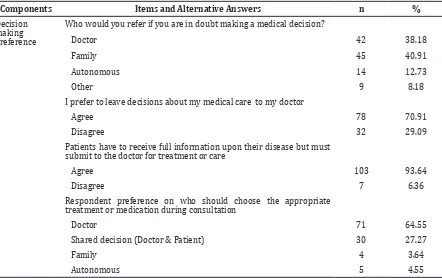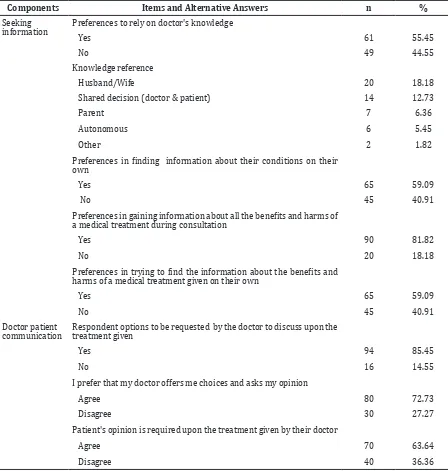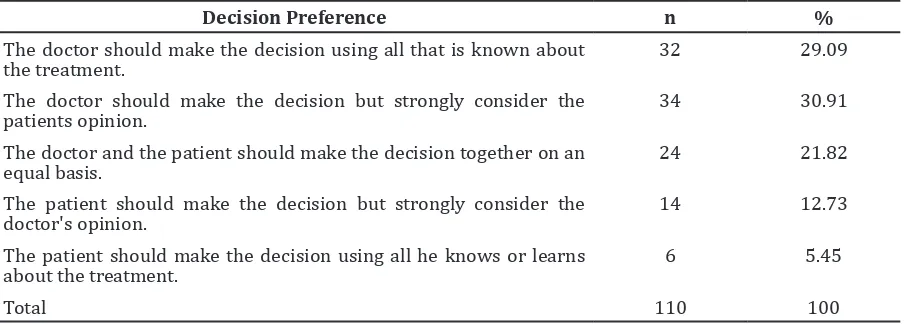Health Information and Decision Making Preference on Disease
Treatment
Muhammad Hasif Bin Mohamed Ali,1 Yoni Syukriani,2 Bambang Sulthana3
1Faculty of Medicine Universitas Padjadjaran, 2Department of Forensic & Legal Medicine Faculty of Medicine Universitas Padjadjaran/Dr. Hasan Sadikin General Hospital Bandung, 3Department
of Surgery Faculty of Medicine Universitas Padjadjaran/Dr. Hasan Sadikin General Hospital Bandung
Abstract
Background: Medical decision making is a complex cognitive process of choosing in establishing a diagnosis and selecting a management option in the context of healthcare. Patients may desire to take part in obtaining and exchanging information, discussing over options and making the final decisions about treatment and or care. The focus of the study was to identify the health information and decision making preference on diseases treatment.
Methods: A descriptive study was conducted to 110 respondents from Hegarmanah Village, Sumedang, Indonesia, aged 18–65 years old who had the experience in consulting doctors for their medical problems. This study was carried out during the period of September to October 2013. The respondents were selected using random stratified sampling. A tested questionnaire, consisted of 2 sections, was used to collect the data. The collected data were presented using frequency tabulation.
Results: Most of the respondents preferred to be offered choices and asked for their opinions by their doctors. Furthermore, 55.45% preferred to rely on physicians for medical knowledge and 93.64% agreed that they had rights in getting all the information on their medical problems, so they submitted their decision to the doctors for care or treatment.
Conclusions: This study shows that preference of the patients varies with regard to how much patients want to participate as one, which may have different preference for different components of the decision making process, yet there is a shift of paradigm from paternalistic to collaborative decicion making between doctor and patient. [AMJ.2015;2(4):463–8]
Keywords: Decision making, doctor patient communication, preference
Correspondence: Muhammad Hasif Bin Mohamed Ali, Faculty of Medicine, Universitas Padjadjaran, Jalan Raya Bandung-Sumedang Km.21, Jatinangor, Sumedang, Indonesia, Phone: +628170208929, Email: haseefali90@gmail.com
Introduction
Autonomy is the paramount feature among four equal medical ethical principles1; thus, patient participation in decision making complement the legal requirement of informed consent. However, most of the patients may prefer to leave their final medical decisions up for their doctors.1,2 Alternately, patient who plays active and collaborative roles in medical decision making in general are viewed as a precursor to a positive and improved health outcomes.3-5 Therefore, every patient wants to participate with a different degree of preference. Some may care for the active role
in discussing during consultation, but in turn they may rely on their physicians to make the ultimate decisions.2
Doctors can support the integrity of patient’s decision making process not only by offering them the opportunity to participate, but also by sharing responsibility and enhance their autonomy with respect to their own preferences.6 In addition, doctors should
promotion programs precisely.2 The aim of the study was to identify the health information and decision making preference on diseases treatment.
Methods
A descriptive study was performed to 110 respondents living in Hegarmanah Village, Jatinangor, Sumedang, West Java during the period of September to October 2013. Hegarmanah village was selected in this study because it is one of the research location for medical students from Faculty of Medicine, Universitas Padjadjaran. The respondents were between 18–65 years old who had the experience in consulting doctors for their medical problems. With these inclusion criteria, the respondents were participating. The sample population was selected by random stratified sampling.
This study constructed a questionnaire by referring to several tools tailored for medical decision making such as the work by Levinson et al.2 , Charles et al.8, Flynn et al.9, and Muller-Engelmann’s10. The questionnaire consisted of three main sections, those were seeking information (5 items), doctor patient communication (3 items), and decision preference (4 items).2,8,9 Moreover, there was
a five-point scales questions for participation in treatment decision making preference, adapted from Sutherland et al. in Muller-Engelmann’s10. All of these items were then translated into Bahasa Indonesia.
After validity and reliability test, several items were modified following the feedbacks of the respondents regarding the clarity of the Indonesian language. Respondents were asked to rate each item justly by the multiple choice options, yes/no or agree/disagree. By frequency analysis, the results were tabulated.
Results
Female respondents who participated in this study were more than half (70.91%) compared to male (29.09%). Most of the respondents were from 32–42 years old age group (39.09%). The majority of the respondents were married (86.36%) and almost half of the respondents classified themselves as housewives (49.09%). The level of education from this study indicated that most of the respondents did not graduate from high school as 36.36% were graduated from elementary school and 28.18% were graduated from junior high school.
From 110 respondents who participated in this study, 91.82% had the experience as ambulatory patients, 20.00% were
Table 1 Distribution of Respondents according to Decision Making Preference
Components Items and Alternative Answers n %
Decision making preference
Who would you refer if you are in doubt making a medical decision?
Doctor 42 38.18
Family 45 40.91
Autonomous 14 12.73
Other 9 8.18
I prefer to leave decisions about my medical care to my doctor
Agree 78 70.91
Disagree 32 29.09
Patients have to receive full information upon their disease but must submit to the doctor for treatment or care
Agree 103 93.64
Disagree 7 6.36
Respondent preference on who should choose the appropriate treatment or medication during consultation
Doctor 71 64.55
Shared decision (Doctor & Patient) 30 27.27
Family 4 3.64
Table 2 Distribution of Respondents according to Health Information
Components Items and Alternative Answers n %
Seeking information
Preferences to rely on doctor's knowledge
Yes 61 55.45
No 49 44.55
Knowledge reference
Husband/Wife 20 18.18
Shared decision (doctor & patient) 14 12.73
Parent 7 6.36
Autonomous 6 5.45
Other 2 1.82
Preferences in finding information about their conditions on their
own
Yes 65 59.09
No 45 40.91
Preferences in gaining information about all the benefits and harms of
a medical treatment during consultation
Yes 90 81.82
No 20 18.18
Preferences in trying to find the information about the benefits and
harms of a medical treatment given on their own
Yes 65 59.09
No 45 40.91
Doctor patient
communication Respondent options to be requested by the doctor to discuss upon the treatment given
Yes 94 85.45
No 16 14.55
I prefer that my doctor offers me choices and asks my opinion
Agree 80 72.73
Disagree 30 27.27
Patient's opinion is required upon the treatment given by their doctor
Agree 70 63.64
Disagree 40 36.36
hospitalized, 3.64% underwent surgery, 1.82% had received other treatments, and 0.91% received blood transfusion. Moreover, 63.64% of the respondents did not seek consultation with a specialist while there were 36.36% respondents who referred to a specialist.
There were approximately more than half of the respondents (55.45%) choose to be passive as they prefer to rely on their doctor’s knowledge during consultation. From 44.55% respondents choosing not to rely completely on their doctor’s knowledge, there
were 18.18% respondents refer red to their husband or wife. Interestingly, 1.83% opted to choose others as they rely on God’s guidance to help them. Moreover, 59.09% respondents were trying to search for an answer on their own as they are intrigue for an answer before consulting their doctor for further diagnosis.
proactive in trying to find themselves on information about the benefits and harms of a medical treatment that were given by their doctor. During consultation, the majority of the respondent (85.45%) opted to be solicitous in deliberating with the doctor in charge of the medication or the treatment given when asked the option to be invited discussing the matters. Moreover, about two-third of the respondent (72.73%) eager to speak out their own opinion when asked whether they prefer to be offered choices and voice out their opinions by their doctors. More than half respondents (63.64%) agreed that their opinions on the treatment given are crucial.
In making the final decision, less than half of the respondent (40.91%) referred their decision to their family when in doubt making a medical decision, yet most of them agreed to leave the decision about their medical care to the doctor.
From the five-point scales of participation in treatment decision making preference, it could be identified that about one-third of the respondents made their decision on medical treatment still according to the decision made by the doctor with the consideration from the patients.
Discussion
This study showed wide variation in preferences for participation in medical decision making. More than half of the respondents still relied on their doctor’s knowledge during consultation. This result of the study shows similar results to studies conducted by Levinson et al.2 and Jahng et
al.4 studies. They stated that the patient still relies on the doctor’s knowledge rather than collaborate to gain the information. Charles et al.8 and Emanuel et al.12 described this evidence as “paternalistic” in which the patient opts to be fiduciary in relationship with their doctors. Yet, there was still respondents who were proactive to seek information other than from their doctors.
There was a shift of paradigm from paternalistic approach to collaborative approach between doctors and patients. Most of the other health information sources were coming from their family such as husband/ wife and parents. This is consistence with Schneider13 findings. He stated that in Asians, there are inclined in medical decision preference towards their family. Interestingly, 1.83% opted to choose others as they rely on God’s guidance to help them. Thus, religion also plays an important role in helping patients making their decisions.
Moreover, the respondents were also asked whether they were trying to find out about their condition on their own or not. More than half of them tried to search for an answer by their own as they intrigued for an answer before consulting their doctor for further diagnosis. This may have impact for doctors to be more persistent and wise during consultation because one might have prior knowledge and “view” on his or her disease weather their opinion are right or wrong. At the same time, people often have misconception on the key facts about important health decisions they make, and there are vital differences between what doctors think patients ought to know and what patients want to know.14 With that, doctors have to be educative and have primacy
Table 3 Distribution of Respondents according to the Participation in Treatment Decision Making Preference10
Decision Preference n %
The doctor should make the decision using all that is known about the treatment.
32 29.09
The doctor should make the decision but strongly consider the patients opinion.
34 30.91
The doctor and the patient should make the decision together on an
equal basis. 24 21.82
The patient should make the decision but strongly consider the doctor's opinion.
14 12.73
The patient should make the decision using all he knows or learns about the treatment.
6 5.45
knowledge in communication skills in order to harmonize patient’s perceptions.15
Most of the respondents expected to be more involved in doctor patient communication. Humans are curious always being asked for reasons and this is similar to Hwa’s findings in Malaysia7 that most of the patients did want to be fully informed on their condition or medication. Respondents who want to be involved and informed regarding their healthcare decisions can be considered as progressive.16 Therefore, to accommodate these “new paradigm” patients, doctors should ask on how they understand their condition and on which level they want to be involved in deciding the treatment. This approach method can be a foundation for doctors seeking an informed, shared decision or collaborative model of care.16
Furthermore, respondents were proactive in trying to find themselves the information about the benefits and harms of a medical treatment given by their doctors. This denotes that the respondents were careful for medication they took.
Family and culture play significant roles in deciding health and communication between doctor and patient in most Asian families.13,17 This norm concurrently comes to pass in this study. In making the final decision, less than half of the respondents refer their decision to their family when in doubt making a medical decision. Interestingly, there was still a few repondents who chose others as they submit themselves to God’s guidance in making decision. This indicates that religion also plays a role in making decisions.
All respondents agreed that they had rights in getting all information on their medical problem but still submit their decision to the doctors for care and treatment. These decision patterns showed that patient wanted to be fully informed on their diagnosis, medication and treatment option but at the same time forego their autonomy for doctor to decide.7 This is supported by their responses toward the question “who should choose the appropriate treatment or medication during consultation?” Most of the respondents preferred that doctor is the one who obligated to choose the suitable treatment for them.
This study has limitation. It did not identify the type and severity of respondents’ diseases that may cause different perception.
It can be concluded that health information and decision making are preferred in treatment of disease vary, yet there is a shift of paradigm from paternalistic to collaborative decicion
making between doctor and patient. The doctors must assess each and every individual preference in making medical decision to ensure that their treatment and care can be tailored and fit to measure. Thus, doctors have to master communication skills to avoid misconception of patients’ perception about their medical problems.
References
1. Gillon R. Ethics needs principles—four can encompass the rest—and respect for autonomy should be “first among equals”. J Med Ethics. 2003;29(5):307–12.
2. Levinson W, Kao A, Kuby A, Thisted R. Not all patients want to participate in decision making. A national study of public preferences. J Gen Intern Med. 2005;20(6):531–5.
3. Hibbard JH. Engaging health care consumers to improve the quality of care. Med care. 2003;41(1Suppl):I61–70.
4. Jahng KH, Martin LR, Golin CE, DiMatteo MR. Preferences for medical collaboration: patient–physician congruence and patient outcomes. Patient Educ Couns. 2005;57(3):308–14.
5. Landon BE, Wilson IB, McInnes K, Landrum MB, Hirschhorn L, Marsden PV, et al. Effects of a quality improvement collaborative on the outcome of care of patients with HIV infection: the EQHIV study. Ann Intern Med. 2004;140(11):887–96.
6. Anyfantakis D, Symvoulakis EK. Medical decision and patient’s preference:’Much Ethics’ and more trust always needed. Int J Med Sci. 2011;8(4):351–352.
7. Hwa YS. Do patients want to be informed and be involved in decision-making?. Kajian Malaysia. 2004;XXII(1):19–46. 8. Charles CA, Whelan T, Gafni A, Willan
A, Farrell S. Shared treatment decision making: what does it mean to physicians?. J Clin Oncol. 2003;21(5):932–6.
9. Flynn KE, Smith MA, Vanness D. A typology of preferences for participation in healthcare decision making. Soc Sci Med. 2006;63(5):1158–69.
10. Müller-Engelmann M, Krones T, Keller H, Donner-Banzhoff N. Decision making preferences in the medical encounter–a factorial survey design. BMC Health Serv Res. 2008;8:260.
2004;52(1):7–16.
12. Emanuel EJ, Grady C. Four paradigms of clinical research and research oversight. Camb Q Healthc Ethics. 2007;16(1):82–96. 13. Schneider SL. The Influence of Cultural
Diversity on Medical, Legal and Financial Decision-Making. FOLO Magazine. 2008; [cited 2012 December 2] Available from: http://www.familiesoflovedones.com/ index.php?option=com_content&task=vie w&id=137&Itemid=41
14. Fraenkel L, McGraw S. Participation in medical decision making: the patients’ perspective. Med Decis Making. 2007;
27(5):533–8.
15. Epstein RM, Alper BS, Quill TE. Communicating evidence for participatory decision making. JAMA. 2004;291(19):2359–66.
16. Kravitz RL, Melnikow J. Engaging patients in medical decision making: the end is worthwhile, but the means need to be more practical. BMJ. 2001;323(7313):584–5. 17. McLaughlin LA, Braun KL. Asian and Pacific


